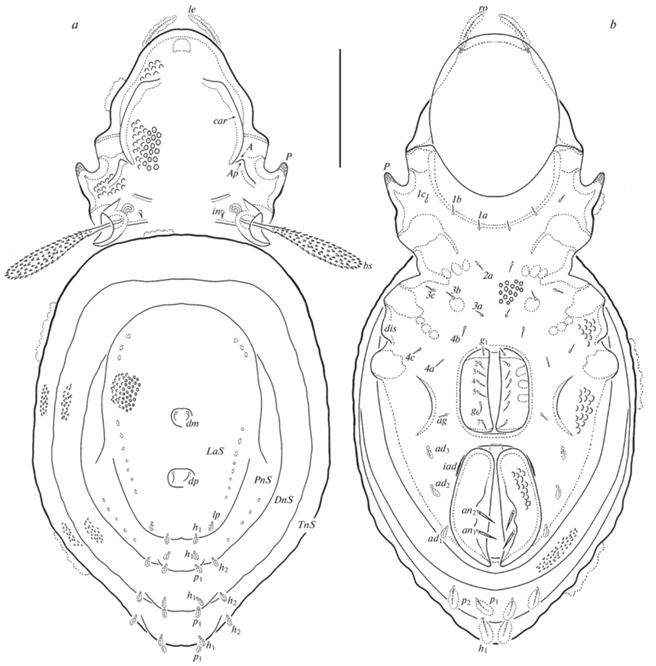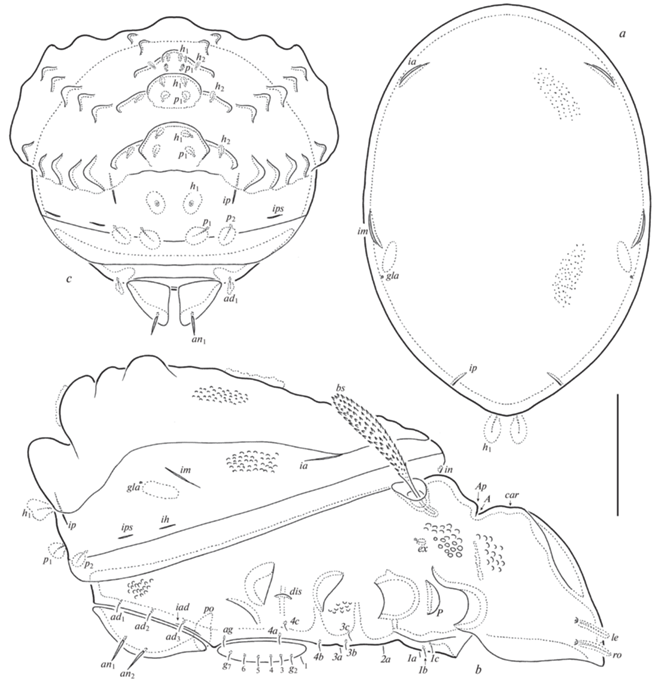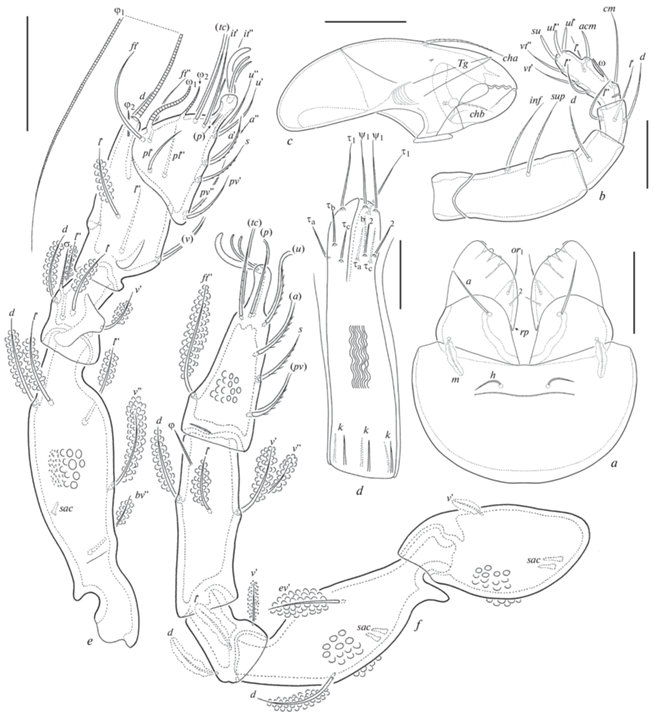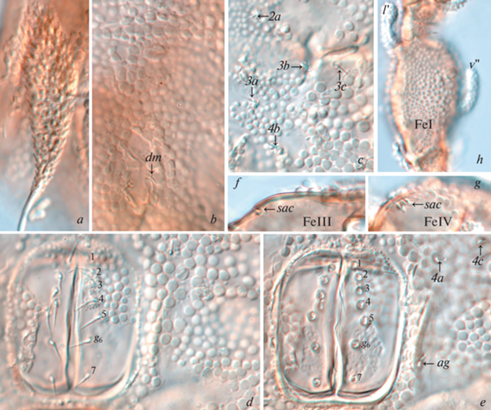Зоологический журнал, 2023, T. 102, № 8, стр. 852-859
Makaroviella exigua (Acari, Oribatida, Licnobelbidae), a new genus and species from Cuba
S. G. Ermilov *
Tyumen State University
625003 Tyumen, Russia
* E-mail: ermilovacari@yandex.ru
Поступила в редакцию 24.03.2023
После доработки 29.03.2023
Принята к публикации 30.03.2023
- EDN: YZHCIF
- DOI: 10.31857/S0044513423080044
Аннотация
A new oribatid mite genus collected from Cuba – Makaroviella gen. n. (Oribatida, Licnobelbidae), with Makaroviella exigua sp. n. as type species – is proposed and described. It can be distinguished from both known licnobelbid genera (Flabellobelba and Licnobelba) mostly by: the number and the localization of notogastral setae, the localization of rostral setae and adanal setae ad1, and the absence of lateral enantiophyses. An identification key to the known species of Licnobelbidae is provided.
Licnobelbidae is a small family of oribatid mites (Acari, Oribatida, Plateremaeoidea), which was proposed by Grandjean (1965). It comprises two genera with three species: Flabellobelba Pérez-Íñigo 1994 (one species) and Licnobelba Grandjean 1931 (two species). The family diagnosis has been summarized by Paschoal (1988), Pérez-Íñigo (1994), Norton and Behan-Pelletier (2009); the generic traits have been summarized by Grandjean (1931), Paschoal (1988), Pérez-Íñigo (1994), Subías and Shtanchaeva (2023). The taxonomic history of licnobelbid species has been provided by Pérez-Íñigo (1993, 1994). The representatives of the family are distributed mostly in the Palaearctic region but Licnobelba caesarea (Berlese 1910) is also known from Mexico (Subías, 2022).
Among the oribatid mite materials collected from the forest leaf litter in Cuba, I found a new species of Licnobelbidae belonging to a new genus. The main goals of this paper are: to describe Makaroviella gen. n., with Makaroviella exigua sp. n. as type species, based on adults; and to provide an identification key for the known species of the family.
METHODS
Observation and documentation. Specimens were mounted in lactic acid on temporary cavity slides for measurement and illustration. Body length was measured in lateral view, from the tip of the rostrum to the posterior edge of the gastronotum. Notogastral width refers to the maximum width of the notogaster in dorsal view. Lengths of body setae were measured in lateral aspect. All body measurements are presented in micrometers. Formulas for leg setation are given in parentheses according to the sequence trochanter-femur-genu-tibia-tarsus (famulus included). Formulas for leg solenidia are given in square brackets according to the sequence genu-tibia-tarsus. Drawings were made with a camera lucida using a Leica transmission light microscope “Leica DM 2500”. Images were obtained with an AxioCam ICc3 camera using a Carl Zeiss transmission light microscope “Axio Lab.A1”.
Terminology. Morphological terminology used in this paper follows that of Grandjean (1931, 1934, 1965), Ermilov and Starý (2021), Ermilov and Salavatulin (2022); Norton (1977) for leg setal nomenclature; Norton and Behan-Pelletier (2009) for overview.
Abbreviations. Prodorsum: car = carina; A = enantiophysis; Ap = posterior tubercle of enantiophysis; ro, le, in, bs, ex = rostral, lamellar, interlamellar, bothridial, and exobothridial seta, respectively. Notogaster: h, p = setae; ia, im, ip, ih, ips = lyrifissures; gla = opisthonotal gland opening. Scalps: LaS, PnS, DnS, TnS = larval, proto-, deuto- and tritonymphal scalp, respectively; dm, dp, lp, h, p = setae. Gnathosoma: rp = process of rutellum; a, m, h = subcapitular setae; or = adoral seta; d, l, sup, inf, cm, ul, su, vt, lt = palp setae; ω = palp solenidion; cha, chb = cheliceral setae; Tg = Trägårdh’s organ. Epimeral and lateral podosomal regions: 1a–1c, 2a, 3a–3c, 4a–4c = = epimeral setae; P = propodolateral apophysis; dis = = discidium. Anogenital region: g, ag, an, ad = genital, aggenital, anal, and adanal seta, respectively; ψ, τ, k = = setae of ovipositor; iad = adanal lyrifissure; po = = preanal organ. Legs: Tr, Fe, Ge, Ti, Ta = trochanter, femur, genu, tibia, and tarsus, respectively; ω, φ, σ = = solenidia; d, l, v, bv, ev, ft, tc, it, p, u, a, s, pv, pl = setae; sac = saccule.
TAXONOMY
Type species: Makaroviella exigua sp. n.
Generic diagnosis (adult). Size. Length less than 300. Integument. Without heavy sculpturing or ornamentation. Cerotegument tuberculate. Prodorsum. Rostrum rounded. Enantiophysis present. Rostral and lamellar setae medium-sized, setiform, ro located anteriorly to le; interlamellar and exobothridial setae short, simple. Bothridial seta elongate leaf-shaped. Notogaster. Scalps tightly attached to the notogaster. Three pairs of short, setiform setae; setae of h-row located distinctly above setae of p-row. Lyrifissures ia, im and ip long. Opisthonotal gland opening located on the notogastral surface (not on the tubercle). Gnathosoma. Subcapitulum diarthric. Two pairs of adoral setae present. Palp setation: 0–2–1–3–9(+1ω); solenidion bacilliform, strongly inclined, directed to the base of acm. Chelicera chelate-dentate. Epimeral and lateral podosomal regions. Epimeral setal formula: 3–1–3–3. Propodolateral apophysis well developed. Discidium present. Anogenital region. With seven pairs of genital, one pair of aggenital, two pairs of anal, and three pairs of adanal setae; all adanal setae located laterally to anal plate. Adanal lyrifissure long, located parallel and close to anal aperture. Legs. Heterotridactylous; claws comparatively small. Femora I–IV and trochanters III, IV with sacculi.
Differential diagnosis. The genus Makaroviella differs from both other known genera of Licnobelbidae – Flabellobelba and Licnobelba – in the following traits.
1. Number and localization of notogastral setae. Makaroviella has three pairs of notogastral setae (h1, p1, p2), all in the posterior part of the notogaster, setae of h-row located distinctly above setae of p-row. Flabellobelba has two pairs of notogastral setae (p2, p3), all in the posterolateral parts of the notogaster, located in one transverse row. Licnobelba has four (lp, h1, p1, p2) or five (lp, h1, p1, p2, p3) pairs of notogastral setae; of these, setae of h- and p-rows are in the posterior part of the notogaster, located in one transverse row, lp shifted in dorsolateral notogastral parts.
2. Localization of rostral setae. In Makaroviella, they are located anteriorly to lamellar setae. In Flabellobelba and Licnobelba, they are located laterally to lamellar setae.
3. Lateral enantiophysis. In Makaroviella, it is absent. In Flabellobelba and Licnobelba, it is present.
4. Localization of adanal seta ad1. In Makaroviella, this seta is located laterally to anal aperture. In Flabellobelba and Licnobelba, it is located posteriorly to anal aperture.
Additionally, Makaroviella differs from Flabellobelba in the morphology of bothridial seta (very short stalk and long head versus very long stalk and short head). Makaroviella differs from Licnobelba in the number of genital setae (seven pairs versus six pairs), and the absence (versus presence) of strong thorn-like structure extending from the bothridium.
Also, Makaroviella is similar to some representatives of the genus Pedrocortesella Hammer 1961 (Licnodamaeidae) in the presence of scalps and in a similar localization of notogastral setae (h1 above p1); however, their body has heavy sculpturing/ornamentation, usually a greater number of notogastral setae, and a weak scalp attachment to the notogaster.
Etymology. The generic name is dedicated to Dr. Olga L. Makarova, a well-known acarologist from the Severtsov Institute of Ecology and Evolution, Russian Academy of Sciences, Moscow, Russia, for her extensive contributions to our knowledge of the taxonomy, biogeography and ecology of mites.
Makaroviella exigua Ermilov sp. n. (Figs 1–4)
Fig. 1.
Makaroviella exigua sp. n., adult: a – dorsal view, b – ventral view (gnathosoma and legs not shown). Scale bar 50 µm.

Fig. 2.
Makaroviella exigua sp. n., adult: a – notogaster, dorsal view (scalps not shown); b – right lateral view (gnathosoma and legs not shown); c – posterior view. Scale bar 50 µm.

Fig. 3.
Makaroviella exigua sp. n., adult: a – subcapitulum, ventral view; b – palp, left, antiaxial view; c – chelicera, left, paraxial view; d – ovipositor, lateral view; e – leg I (trochanter not shown), left, paraxial view; f – leg IV, left, antiaxial view. Scale bar, μm: a, c–f – 20; b – 10.

Fig. 4.
Makaroviella exigua sp. n., adult, microscope images: a – bothridial seta; b – cerotegument on larval scalp; c – cerotegument in epimeral region; d – genital plates; e – genital plates, deep focus; f – saccule on leg femur III; g – saccules on leg femur IV; h – cerotegument on leg femur I. Magnification: 10 × 100.

Type material. Holotype (♀) and nine paratypes (6♂, 3♀): Cuba, 22°6′ N, 81°6′ W, leaf litter in a riparian mixed forest (unknown date and collector; collection of the Tyumen State University Museum of Zoology, Tyumen, Russia).
The holotype is deposited in the collection of the Senckenberg Museum of Natural History, Görlitz, Germany; nine paratypes are deposited in the collection of the Tyumen State University Museum of Zoology, Tyumen, Russia. All specimens are preserved in 70% solution of ethanol with a drop of glycerol.
Diagnosis. Body length: 240–270. Body covered by layer of dense tuberculate cerotegument. Dorsolateral part of prodorsum with longitudinal carina. Enantiophysis present, formed by the posterior part of carina and the opposite tubercle. Bothridial seta with short stalk and long, leaf-shaped head which is covered by dense microscales. Posterolateral part of bothridium slightly protruding. Notogastral, epimeral, anogenital, and scalpal setae short, setiform (except anal setae slightly phylliform). Subcapitular mentum with transverse ridge posteriorly to insertions of h. Tubercles of parastigmatic enantiophysis absent. Discidium present. Leg femora I–III and trochanter III with one saccule; femur IV and trochanter IV with two sacculi.
Description. Measurements. Body length: 270 (holotype), 240–255 (male paratypes), 270 (female paratypes); notogaster width: 135 (holotype), 120 (male paratypes), 135 (female paratypes).
Integument. Body color light brown. Body, setae and legs covered by layer of dense tuberculate cerotegument (diameter of large tubercles up to 6; diameter of small tubercles less than 1). Surface of notogaster microtuberculate sculpturing (visible under high magnification).
Prodorsum. Rostrum broadly rounded. Dorsolateral part with longitudinal carina which is slightly convex to the outside; a pair of carinae are well separated. Enantiophysis present, formed by the posterior part of carina and the opposite tubercle. Rostral and lamellar setae (19–22) setiform, roughened; interlamellar (4) and exobothridial (4–6) setae setiform, smooth; bothridial seta (49–56) with short stalk and long, elongate leaf-shaped head covered by dense microscales. Posterolateral part of bothridium slightly protruding.
Notogaster. Scalps present in all specimens, without heavy reticulate/foveolate ornamentation. Larval scalp with four pairs (dm, dp, lp, h1), nymphal scalps with three pairs (h1, h2, p1) of observed setae; all setae short (4–6), setiform, smooth. Notogastral setae (h1, p1, p2) short (4–6), setiform, smooth. Opisthonotal gland elongate oval; opening small, poorly observed. All lyrifissures distinct, located on slight elongate tubercles.
Gnathosoma. Subcapitulum size: 67–71 × 52–56; subcapitular (a: 13–15; m: 9–11; h: 7–9) and adoral (or1: 9–11; or2: 4–6) setae setiform, smooth; rutellum with posteromedial process; mentum with transverse ridge posteriorly to insertions of h. Palp length: 45–49; postpalpal seta (4) spiniform, smooth. Chelicera length: 67–71; setae (cha: 22–26; chb: 13–15) setiform, slightly barbed.
Epimeral and lateral podosomal regions. All setae (4–6) setiform, smooth. Tubercles of parastigmatic enantiophysis absent. Discidium poorly visible, with rounded top.
Anogenital region. Genital, aggenital and adanal setae (4–6) setiform, smooth; anal seta (11–13) slightly phylliform, smooth. Anal lyrifissure not observed; adanal lyrifissure long, located parallel and very close to anal aperture. Slight depression located laterally to genital aperture. Ovipositor elongated (82–86 × 19), all three blades (26–30) shorter than length of distal section (beyond middle fold; 56); setae of blades (ψ1, τ1: 19; ψ2, τa, τ2, τc: 11) and coronal setae (11) rod-like, smooth.
Legs. Claws smooth. Tibia I with dorsodistal cylindrical apophysis bearing two solenidia and seta. Femora I–III and trochanter III with one dorsal saccule; femur IV and trochanter IV with two dorsal sacculi. Formulas of leg setation and solenidia: I (1–5–4–5–18) [1–2–2], II (1–5–4–5–15) [1–1–2], III (2–3–3–4–15) [1–1–0], IV (1–2–3–4–12) [0–1–0]; homology of setae and solenidia indicated in Table 1. Famulus sunken; seta s on tarsus I setiform, barbed (not eupathidial), located between paired setae a and pv. Solenidion φ1 on tibia I long, subflagellate; other solenidia short of medium-sized, rod-like or slightly bacilliform.
Table 1.
Leg setation and solenidia of adult Makaroviella exigua sp. n.
| Leg | Tr | Fe | Ge | Ti | Ta |
|---|---|---|---|---|---|
| I | v' | d, (l), bv'', v'' | d, (l), v', σ | (l), (v), dφ1, φ2 | (ft), (tc), (it), (p), (u), (a), s, (pv), (pl), ɛ (sunken), ω1, ω2 |
| II | v' | d, (l), bv'', v'' | d, (l), v', σ | d, (l), (v), φ | (ft), (tc), (it), (p), (u), (a), s, (pv), ω1, ω2 |
| III | l ', v' | d, l ', ev' | d, l ', v', σ | d, l ', (v), φ | (ft), (tc), (it), (p), (u), (a), s, (pv) |
| IV | v' | d, ev' | d, l ', v' | d, l ', (v), φ | ft '', (tc), (p), (u), (a), s, (pv) |
Etymology. The specific epithet exigua is Latin for “small” and alludes to the body size.
KEY TO KNOWN SPECIES OF LICNOBELBIDAE
1 Four or five pairs of notogastral setae, lp present; six pairs of genital setae; bothridium with strong thorn-like structure extending from the bothridium ………………………..…...............................2
– Two or three pairs of notogastral setae, lp absent; seven pairs of genital setae; bothridium without thorn-like structure extending from the bothridium ………......3
2 Four pairs of notogastral setae, p3 absent; tritonymphal scalp with anterior process; prodorsum without cerotegumental network pattern; longitudinal and transverse prodorsal carinae forming H-structure; prodorsal enantiophysis well developed; notogastral lyrifissure im short; body length: 266–450 ………… Licnobelba latiflabellata (Paoli 1908) [see Paoli, 1908; Grandjean, 1931 – as L. alestensis; Mihelčič, 1957 – as L. montana; Pérez-Íñigo, 1970 – as L. montana; Seniczak et al., 2012]. Distribution: Western Palaearctic (except North) and West of Eastern Palaearctic.
– Five pairs of notogastral setae, p3 present; tritonymphal scalp without anterior process; prodorsum with cerotegumental network pattern; longitudinal and transverse prodorsal carinae absent; prodorsal enantiophysis poorly observed; notogastral lyrifissure im long; body length: 250–302 ……………… Licnobelba caesarea (Berlese 1910) [see Berlese, 1910; Grandjean, 1931; Pérez-Íñigo, 1970, 1994; Ayyildiz, Toluk, 2016]. Distribution: Mediterranean, Mexico.
3 Two pairs of notogastral setae, all located in the posterolateral parts, in one transverse row; rostral seta located laterally to lamellar seta; bothridial seta with very long stalk and short head; prodorsal enantiophysis formed by two tubercles; prodorsum with cerotegumental network pattern; lateral enantiophysis present; adanal seta ad1 located posteriorly to anal aperture; body length: 400–418 ………………………. Flabellobelba almeriensis (Ruiz, Kahwash et Subías 1990) [see Ruiz et al., 1990; Pérez-Íñigo, 1994]. Distribution: Spain.
– Three pairs of notogastral setae, all located in the posterior part of the notogaster, setae of h-row located distinctly above setae of p-row; rostral seta located anteriorly to lamellar seta; bothridial seta with very short stalk and long head; prodorsal enantiophysis formed by posterior part of carina and the opposite tubercle; prodorsum without cerotegumental network pattern; lateral enantiophysis absent; adanal seta ad1 located laterally to anal aperture; body length: 240–270 …………. Makaroviella exigua sp. n. Distribution: Cuba.
Список литературы
Ayyildiz N., Toluk A., 2016. Contributions to the Turkish oribatid mite fauna (Acari: Oribatida) // Turkish Journal of Entomology. V. 40. № 1. P. 73–85.
Berlese A., 1910. Acari nuovi. Manipulus V–VI // Redia. V. 6. P. 199–234.
Ermilov S.G., Salavatulin V.M., 2022. Ontogenetic instars of Gymnodamaeus uslaminorum sp. nov. (Acari, Oribatida, Gymnodamaeidae) from Russia // International Journal of Acarology. V. 48. № 2. P. 98–105.
Ermilov S.G., Starý J., 2021. New faunistical and taxonomic data on oribatid mites of the superfamily Plateremaeoidea (Acari, Oribatida) of Bolivia // Systematic and Applied Acarology. V. 26. № 7. P. 1361–1373.
Grandjean F., 1931. Le genre Licneremaeus Paoli (Acariens) // Bulletin de la Société zoologique de France. V. 56. P. 221–250.
Grandjean F., 1934. Oribates le l’Afrique du Nord (2me Série) // Bulletin de la Société d’histoire naturelle de l’Afrique du Nord. V. 25. P. 235–252.
Grandjean F., 1965. Nouvelles observations sur les Oribates (4e série) // Acarologia. V. 7. № 1. P. 91–112.
Mihelčič F., 1957. Oribatiden Südeuropas VII // Zoologischer Anzeiger. V. 159. P. 44–68.
Norton R.A., 1977. A review of F. Grandjean’s system of leg chaetotaxy in the Oribatei (Acari) and its application to the family Damaeidae // In: Dindal D.L., editor. Biology of oribatid mites. Syracuse, SUNY College of Environmental Science and Forestry. P. 33–61.
Norton R.A., Behan-Pelletier V.M., 2009. Oribatida // A Manual of Acarology (TX). Lubbock: Texas Tech University Press. P. 430–564.
Paoli G., 1908. Monografia del genere Dameosoma Berl. e generi affini // Redia. V. 5. P. 31–91.
Paschoal A.D., 1988. A revision of the families Licnodamaeidae and Licnobelbidae (Acari: Oribatei) with a recharacterization of the genera Licnodamaeus and Licnobelba // Revista Brasileira de Zoologia. V. 3. № 6. P. 397–403.
Pérez-Iñigo C., 1970. Acaros Oribátidos de suelos de España Peninsular e Islas Baleares (Acari, Oribatei). Parte II // Eos. V. 45.P. 241–317.
Pérez-Iñigo C., 1993. Redescription of Licnobelba latiflabellata (Paoli, 1908) (Acari, Oribatei, Licnobelbidae) // Redia. V. 76. № 2. P. 317–326.
Pérez-Iñigo C., 1994. Redescriptions of Licnobelba caesarea (Berlese, 1910) and Flabellobelba almeriensis (Ruiz, Kahwash and Subias, 1990). The genus Flabellobelba n.g. and redefinition of the Family Licnobelbidae (Acari, Oribatei) // Redia. V. 57. № 2. P. 241–250.
Ruiz E., Kahwash M.A.M., Subias L.S., 1990. Cuatro nuevos Gymnodamaeoideos del Sur de España. (Acari, Oribatida, Gymnodamaeoidea) // Boletín de la Real Sociedad Española de Historia Natural. V. 85. № 1–4. P. 39–49.
Seniczak S., Ayyıldız N., Seniczak A., 2012. Setal losses in the dorsal hysterosoma of Plateremaeoidea (Acari: Oribatida) in the light of ontogenetic studies // Journal of Natural History. V. 46. № 7–8. P. 411–451.
Subías L.S., 2022. Listado sistemático, sinonímico y biogeográfico de los ácaros oribátidos (Acariformes: Oribatida) del mundo (excepto fósiles) // Monografías Electrónicas S.E.A. V. 12. P. 1–538.
Subías L.S., Shtanchaeva U.Ya., 2023. Claves de familias, géneros y subgéneros de ácaros oribátidos del mundo (Acari, Oribatida) // Monografías Electrónicas S.E.A. V. 13. P. 1–290.
Дополнительные материалы отсутствуют.
Инструменты
Зоологический журнал


